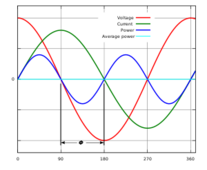curiouscarbon
Science Penguin
- Joined
- Jun 29, 2020
- Messages
- 3,024
So is MV Milli Vanilli?I was taught to remember that if the unit is named after a person it is capitalised;
So V for volts (Alessandro Volta)
A for amps (André-Marie Ampère)
W for watts (James Watt)
K for kelvin (William Kelvin)
But unfortunately there are exceptions with name clashes; and because M is used for Mega (as m=milli) and G for Giga (g=gram), I guess that's why people put K for kilo so often.
I wish I knew more Nerds to share this hilarious graphicfor AC where voltage is sine wave like


There's just so much wrong with this.The value of 120 vac is the RMS or root mean square of the sign wave. Sign wave starts at 0 deg peaks at 90 deg and drops to zero crossing the zero axis and peaks at minus 180 degs or 270 degrees if you prefer. Then returns to zero and repeats. At 45 degs we use the cosign of 45 degs times the peak voltage to come up with 120 vac.
Again just simpler to say VA=WATTS.
This part is pretty much correct. 'Sine' wave, but the intent was clear enough.The value of 120 vac is the RMS or root mean square of the sign wave.
Sign wave starts at 0 deg peaks at 90 deg and drops to zero crossing the zero axis and peaks at minus 180 degs or 270 degrees if you prefer. Then returns to zero and repeats.
cosine, not cosign... But this is just wrong. RMS is not 'the value at 45 degrees'. For a sine wave the RMS is the peak voltage divided by the square root of 2, and this coincidentally is the voltage at 45 degrees (because cos(45) is equal to 1/2^0.5).At 45 degs we use the cosign of 45 degs times the peak voltage to come up with 120 vac.
And you've missed the entire point of this whole post. VA would equal Watts if the voltage and current were in phase. For DC systems they are because the voltage doesn't vary.Again just simpler to say VA=WATTS.

Thanks for the spell checks and corrections.There's just so much wrong with this.
This part is pretty much correct. 'Sine' wave, but the intent was clear enough.
SignSine wave starts at 0 deg peaks at 90 deg and drops to zero crossing the zero axisand peaksatminus180 degs, then peaks again with opposite polarity ator270 degrees (or negative 90 degrees) if you prefer.
cosine, not cosign... But this is just wrong. RMS is not 'the value at 45 degrees'. For a sine wave the RMS is the peak voltage divided by the square root of 2, and this coincidentally is the voltage at 45 degrees (because cos(45) is equal to 1/2^0.5).
And you've missed the entire point of this whole post. VA would equal Watts if the voltage and current were in phase. For DC systems they are because the voltage doesn't vary.
But for AC systems they may not be in phase: for inductive loads (most ac motors, for example) the voltage and current both follow sine waves but they peak at different times.
Apparent Power (VA) is the RMS of (voltage curve * current curve). Note that this isn't the same as the RMS of the voltage curve * RMS of the current curve.
Whereas Real Power (W) is the average of (voltage curve * current curve).
In the extreme case where the voltage and current curves are separated by 90 degrees, the Real Power (W) can be zero while the Apparent Power (VA) is certainly not:
View attachment 191300
Not familiar with the Kelvin-Watt-hour...
And I let you pull my chain!At least someone understood my joke!
Does that apply to solar panels or inverters made in China ? They use a leap month instead of a leap year. If so, what’s the mathematical formula for that?It's the amount power in solar units produced in a fortnite in a leap year.
Does that apply to solar panels or inverters made in China ? They use a leap month instead of a leap year. If so, what’s the mathematical formula for that?
If kWh = kW * time and is 1 hour, if trying to figure out 1 minute, is it as simple as dividing the kWh number by 60? Yesterday was trying to get amps from Emporia, but that is all in kWh or Watts at the min / sec level. Or, if Emporia gives it to me in Watts, not kWh, then it's watts / Volts = current amp draw?I can see occasionally that someone puts down just watts when they really mean watt-hours. It often can be inferred by the context of the post. But I sure do agree that some have a difficulty with understanding watt over time is how we measure electrical production or commonly called power. Especially it is the case when they have a bit more complication like running watts for less than an hour. 1000w for 15minutes? How is that possible?
Although the math is fairly basic it seems that many balk at applying it.
KWh = kW x time (in hours)kWh = kW+time
Thanks, corrected.KWh = kW x time (in hours)
If you're trying to get amps on Emporia thenIf kWh = kW * time and is 1 hour, if trying to figure out 1 minute, is it as simple as dividing the kWh number by 60? Yesterday was trying to get amps from Emporia, but that is all in kWh or Watts at the min / sec level. Or, if Emporia gives it to me in Watts, not kWh, then it's watts / Volts = current amp draw?
 on the top left, select "Units of Measurement" then select amps. Walla!
on the top left, select "Units of Measurement" then select amps. Walla!That’s very cool. Thanks for that!!If you're trying to get amps on Emporia then
Click click on the hamburger View attachment 194419 on the top left, select "Units of Measurement" then select amps. Walla!
And yes, Watts/Volts = Amps
For example
1200 watts / 120v = 10 amps
or
1200 watts / 240v = 5 amps


